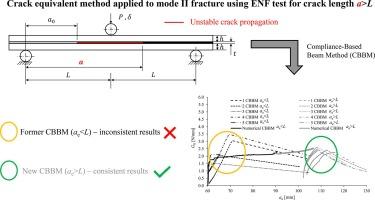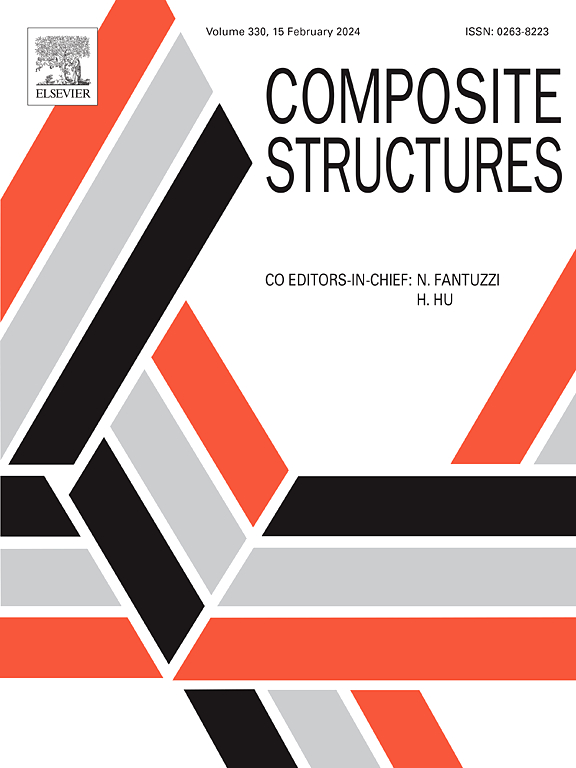利用 ENF 试验扩展应用于热塑性复合材料粘接接头模式 II 断裂的裂缝等效方法
IF 6.3
2区 材料科学
Q1 MATERIALS SCIENCE, COMPOSITES
引用次数: 0
摘要
热塑性复合材料(TPC)是新一代的环保材料,其基体更加坚韧,能够克服热固性材料的主要弱点,即抗分层能力差和回收困难。虽然 TPC 材料的表面能较低,但在不符合熔融粘合程序要求的情况下,粘合剂粘合仍然有效。粘合剂技术的最新进展揭示了双组分丙烯酸粘合剂专为 TPC 材料所特有的低能表面而设计。在这项工作中,采用端部缺口挠曲(ENF)试验对单向碳增强聚酰胺 6(CF/PA6)粘接接头在纯模式 II 负载下的性能进行了表征。实验性断裂测试显示了不稳定的裂纹扩展,基于等效裂纹概念开发了一种数据还原方案,以获得沿裂纹前沿试样长度超出致动器中心加载点的应变能释放率分布。利用包括内聚区建模在内的有限元分析成功验证了所提出的程序,并将其应用于实验结果。所获得的阻力曲线表明,即使在 TPC 材料特有的低能量表面,这种粘合剂也能在纯模式 II 加载中提供显著的粘合阻力。本文章由计算机程序翻译,如有差异,请以英文原文为准。

Extension of the crack equivalent method applied to mode II fracture of thermoplastic composites bonded joints using the ENF test
Thermoplastic based composites (TPC) have emerged as a new generation of eco-friendly materials with tougher matrices capable of overcoming the major weaknesses of the thermoset counterparts related with poor resistance to delamination and recycling difficulties. Although TPC materials present low surface energy, adhesive bonding is still effective when the requirements for fusion bonding procedures are not met. Recent advances in adhesive technology have unveiled two-part acrylic adhesive specifically designed for low energy surfaces, characteristic of TPC materials. In this work, unidirectional carbon-reinforced polyamide 6 (CF/PA6) bonded joint was characterized under pure mode II loading using end-notched flexure (ENF) test. The experimental fracture tests revealed unstable crack propagation and a data reduction scheme based on the equivalent crack concept was developed to obtain the strain energy release rate distribution along the crack front for the specimen’s length beyond the actuator central loading point. The proposed procedure was successfully validated using a finite element analysis including a cohesive zone modelling and applied to the experimental results. The obtained Resistance-curves showed that this adhesive is capable to provide a significant bonding resistance in pure mode II loading even in low energy surfaces characteristic of TPC materials.
求助全文
通过发布文献求助,成功后即可免费获取论文全文。
去求助
来源期刊

Composite Structures
工程技术-材料科学:复合
CiteScore
12.00
自引率
12.70%
发文量
1246
审稿时长
78 days
期刊介绍:
The past few decades have seen outstanding advances in the use of composite materials in structural applications. There can be little doubt that, within engineering circles, composites have revolutionised traditional design concepts and made possible an unparalleled range of new and exciting possibilities as viable materials for construction. Composite Structures, an International Journal, disseminates knowledge between users, manufacturers, designers and researchers involved in structures or structural components manufactured using composite materials.
The journal publishes papers which contribute to knowledge in the use of composite materials in engineering structures. Papers deal with design, research and development studies, experimental investigations, theoretical analysis and fabrication techniques relevant to the application of composites in load-bearing components for assemblies, ranging from individual components such as plates and shells to complete composite structures.
 求助内容:
求助内容: 应助结果提醒方式:
应助结果提醒方式:


